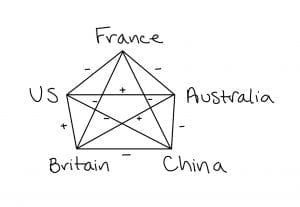Structural Balance in International Affairs
In class, we recently learned about the structural balance property, which states that a graph which has edges between all present nodes has balance between the positive and negative relationships within. One of the examples given in class was alliances in WWII, and an article I found by Roger Cohen for the New York Times reminded me of how these international relationships can often be illustrated using graphs. In the article, Cohen discusses how the US and Australia both seem to have damaged their relationships with France by working with each other and Britain to provide nuclear powered and armed submarines to Australia for use in the larger Indo-Pacific region. France expressed their anger in a number of ways, one of which was through a statement saying “the American choice to exclude a European ally and partner such as France… shows a lack of coherence.” Since these submarines seem to be a reaction to China’s current expansionist policies within the Indo-Pacific region, they also angered China. While the US, Britain, Australia, and France all oppose China’s human rights policies to some extent, because their strategies in relation to China are different, they are not all in the same block.
In this graph, illustrating relations described in the article “In Submarine Deal With Australia, U.S. Counters China but Enrages France,” the structural balance property can be found in the triangles within the graph. For example, the triangle between the US, Australia, and China illustrates a balanced network in which the US and Australia have positive relations with one another and have negative relations with China. The triangle between the US, Australia, and Britain also illustrates a balanced graph where all the nodes have positive relations with one another. Since both France and China are included, and do not have positive relations with each other or with the US, Australia, and Britain block, this network is not completely balanced.
Article: https://www.nytimes.com/2021/09/16/world/europe/france-australia-uk-us-submarines.html

